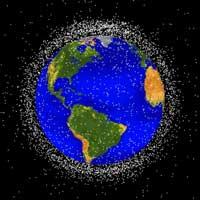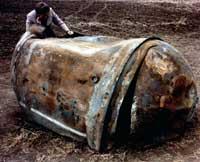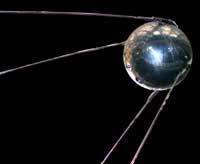Non-planetary landfill

Space junk is called artificial objects that revolve around Earth and do not perform functions. Space garbage consists of fragments of ancient rockets and satellites, remains of explosions, etc. To control all of them, scientists follow up. Currently there are 10,000 catalogued objects, but they estimate that there may be 50,000, there are 100 tons of trash that revolve around the Earth.
Most of the waste is in orbit 2,000 kilometers from the Earth's surface. In this orbit the rubbish fragments can go at a speed of 7 and 8 kilometers per second. Therefore, even if they are small, due to the speed they carry, they can cause great damage and can pose a risk to operating satellites or to carry out various space missions.
These fragments that form the spillway lose speed over the years and fall to Earth, but when they meet the atmosphere, most burn and disappear. Only some are as large as to cross the atmosphere and fall to Earth.
But the little garbage that we have put humans in space and the parts that make up the garbage get in touch, thus creating more pieces or objects. It is estimated that from 2055, as a consequence of collisions between them, the number of objects will increase exponentially and it will be practically impossible to leave the Earth to space.
Crazy solutions
Faced with this problem, they have been looking for solutions for some time, but they have not yet found a technically and economically possible solution.

One of them is the giant foam rubber ball: Placing in orbit a large ball of 1.5 kilometers in diameter, it would hit and order objects in orbit. The smallest objects, being the foam ball, would cross them and not be ordered. However, they would lose speed and fall before the orbit. But the ball would not separate the trash from the satellite running, so it would cause damage to communications, etc.
Another solution is to use a laser. Using a laser, hit objects and remove them from the orbit. But lasers do not work with all materials and are very expensive. So far this solution is also ruled out.
More viable solution
Scientists propose inserting some straps, a kind of rope, to objects that are thrown into space. Thus, once the satellite has failed or its function ends, it could pull them out of the orbit. But, although theoretically possible, in practice they have not achieved good results.

Other proposals are the spacing of containers that collect garbage and the placement of propulsors to large fractions of garbage that move them in the right direction.
Although they give crazy ideas, they are true and proposed by NASA scientists. If future shots into space are cheaper and techniques improve, scientists believe it may be possible to carry out one of them.
Published in 7K.
Buletina
Bidali zure helbide elektronikoa eta jaso asteroko buletina zure sarrera-ontzian











